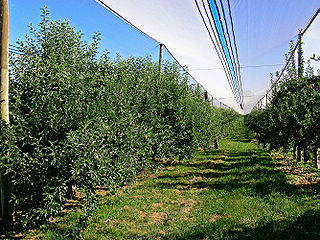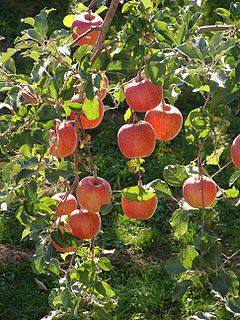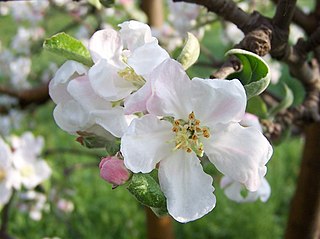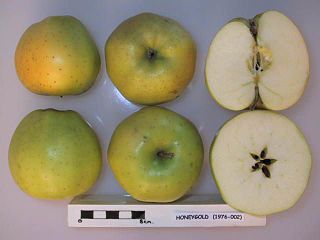
The McIntosh, McIntosh Red, or colloquially the Mac, is an apple cultivar, the national apple of Canada. The fruit has red and green skin, a tart flavour, and tender white flesh, which ripens in late September. In the 20th century it was the most popular cultivar in Eastern Canada and New England, and is considered an all-purpose apple, suitable both for cooking and eating raw. Apple Inc. employee Jef Raskin named the Macintosh line of personal computers after the fruit.

'Golden Delicious' is a yellow apple, one of the 15 most popular cultivars in the United States. It is not closely related to 'Red Delicious'.

Malus is a genus of about 30–55 species of small deciduous trees or shrubs in the family Rosaceae, including the domesticated orchard apple – also known as the eating apple, cooking apple, or culinary apple. The other species are commonly known as crabapples, crab apples, crabtrees, wild apples, or rainberries.

The 'Red Delicious' is a clone of apple cultigen, now comprising more than 50 cultivars, first recognized in Madison County, Iowa, in 1872. It is one of the fifteen most popular apple cultivars in the United States. From 1968 to 2018, it was the most produced cultivar in the U.S.

The Fuji apple is an apple cultivar developed by growers at Tohoku Research Station (農林省園芸試験場東北支場) in Fujisaki, Aomori, Japan, in the late 1930s, and brought to market in 1962. It originated as a cross between two American apple varieties—the Red Delicious and old Virginia Ralls Janet apples. According to the US Apple Association website it is one of the fifteen most popular apple cultivars in the United States. Its name is derived from the first part of the town where it was developed: Fujisaki.

Gala is a clonally propagated apple cultivar with a mild and sweet flavour. In 2018, it surpassed Red Delicious as the apple cultivar with the highest production in the United States, according to the US Apple Association. It was the first time in over 50 years that any cultivar was produced more than Red Delicious.

Honeycrisp is an apple cultivar developed at the Minnesota Agricultural Experiment Station's Horticultural Research Center at the University of Minnesota, Twin Cities. Designated in 1974 with the MN 1711 test designation, patented in 1988, and released in 1991, the Honeycrisp, once slated to be discarded, has rapidly become a prized commercial commodity, as its sweetness, firmness, and tartness make it an ideal apple for eating raw. "...The apple wasn't bred to grow, store or ship well. It was bred for taste: crisp, with balanced sweetness and acidity." It has larger cells than most apple cultivars, a trait which is correlated with juiciness, as theoretically a higher number of cells rupture when bitten releases more juice in the mouth. The Honeycrisp also retains its pigment well and has a relatively long shelf life when stored in cool, dry conditions. Pepin Heights Orchards delivered the first Honeycrisp apples to grocery stores in 1997. The name Honeycrisp was trademarked by the University of Minnesota, but university officials were unsure of its protection status in 2007. It is now the official state fruit of Minnesota.

'Ambrosia' is a cultivar of apple originating in British Columbia, Canada in the early 1990s. The original tree was first cultivated by the Mennell family of Similkameen Valley, British Columbia, who discovered it growing in their orchard.

Empire is the name of a clonally propagated cultivar of apple derived from a seed grown in 1945 by Lester C. Anderson, a Cornell University fruit nutritionist who conducted open pollination research on his various orchards. In 1945, under the direction of A. J. Heinicke, scientists from the New York State Agricultural Experiment Station of Cornell University in Geneva, New York, harvested the Empire seed together with thousands of its siblings. The Geneva teams grew and tested ever dwindling sub-populations of the sibling group until 1966, when the final selection, the Empire, was released to the public at the New York Fruit Testing Association meetings in Geneva. According to the US Apple Association website it is one of the fifteen most popular apple cultivars in the United States.

Stark Bro's Nurseries & Orchards Co. is a horticultural company based in Louisiana, Missouri, that specializes in growing and selling fruit trees to home gardeners and commercial orchardists. The company was the original marketer of the Red Delicious and Golden Delicious apples.

An apple is an edible fruit produced by an apple tree. Apple trees are cultivated worldwide and are the most widely grown species in the genus Malus. The tree originated in Central Asia, where its wild ancestor, Malus sieversii, is still found today. Apples have been grown for thousands of years in Asia and Europe and were brought to North America by European colonists. Apples have religious and mythological significance in many cultures, including Norse, Greek, and European Christian tradition.

Sekai ichi is a cultivar of apples first released from Japan in 1974. It is considered one of the largest varieties of apples, with an average circumference of 30 to 46 centimetres and weight of 900 grams. Sekai ichi means "world's number one" in Japanese.

Anna apple is a dual purpose cultivar of domesticated apple that is very early ripening and does well in warm climates.
Enterprise is a modern bred, late-ripening and attractive, red cultivar of domesticated apple with excellent fruit quality combined with disease resistance to scab, cedar apple rust, fire blight and some resistance to powdery mildew. The fruit is large and attractive and retains excellent fresh quality for up to six months at 1°C. Its moderate acidity at time of harvest mellows in storage, and it is best after one month of storage.

'Crimson Gold' is a modern cultivar of applecrab, meaning that it is a cross between a crabapple and a domesticated apple. It is a small apple.

'Honeygold' is a cold-hardy cultivar of domesticated apple, which was developed to suit for the northern cold areas. It was developed by the Minnesota Agricultural Experiment Station's Horticultural Research Center of the University of Minnesota. They were crossing a Golden Delicious with a Haralson in order to obtain a Golden Delicious style fruit with the cold hardiness of the Haralson, a goal which was successfully achieved.

Autumn Glory is an apple cultivar developed by Domex Superfresh Growers, which is based in Washington (state). The fruit is marketed as Autumn Glory. The fruit, which has cinnamon tasting notes, is grown by Domex Superfresh Growers with a production of about 56,000 trees as of November 2014. Autumn Glory apples have a very sweet, firm flesh with hints of cinnamon and subtle notes of caramel. After being in development for a decade, the apple was released in the 2011 season. The Autumn Glory variety is a hybrid of the Fuji (apple) and Golden Delicious apple with a red coloring on a yellow background. The original pollination cross breed was made by Dr. Yu Lin Wang in 1976. It is picked in mid- to late-October of each year.

Cripps Red is a cultivar of apples; the fruit are eaten fresh. The original tree was bred by John Cripps from Golden Delicious × Lady Williams. The fruit mature very late in the season. Cripps Red fruit can be marketed as Sundowner apples, if they are sufficiently good quality and are also sold as Joya in Europe. Cripps Pink and Western Dawn (Enchanted) apples have the same parentage as Cripps Red.

Cosmic Crisp is an American apple with the variety designation 'WA 38'. Breeding began in 1997 at the Washington State University (WSU) Tree Fruit Research and Extension Center in Wenatchee, Washington, initially overseen by Bruce Barritt and now by Kate Evans.

EverCrisp is an American apple cultivar developed by the Midwest Apple Improvement Association (MAIA). Trademarked as EverCrisp, the MAIA-1 variety is a cross between two existing apple cultivars – the Honeycrisp and Fuji. Originally produced in Ohio, EverCrisp has since expanded to apple-growing regions across the Midwest in Michigan, Illinois and Indiana, and in the Northeast in Pennsylvania and New York. The apple entered the public marketplace in 2017.




















